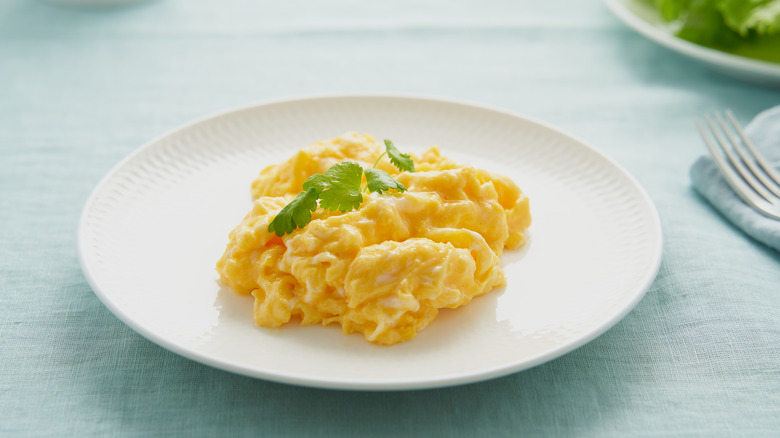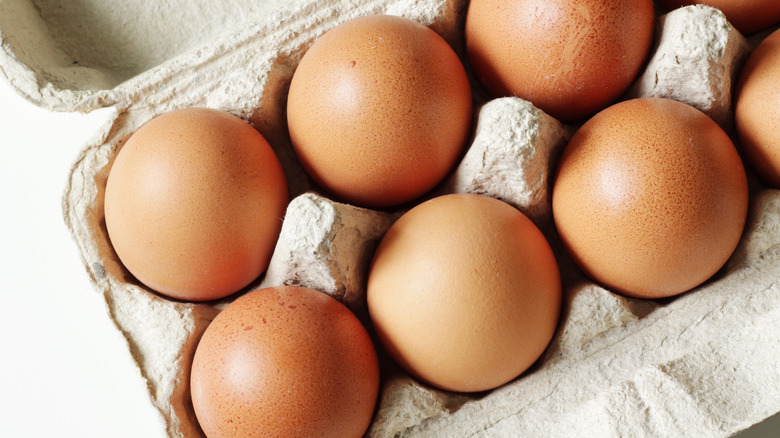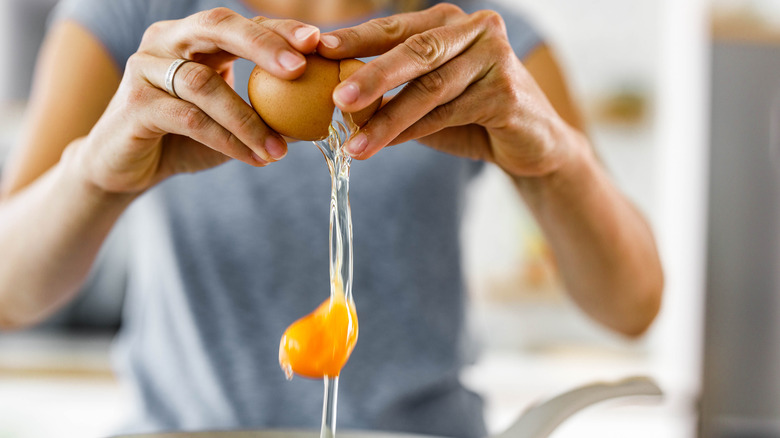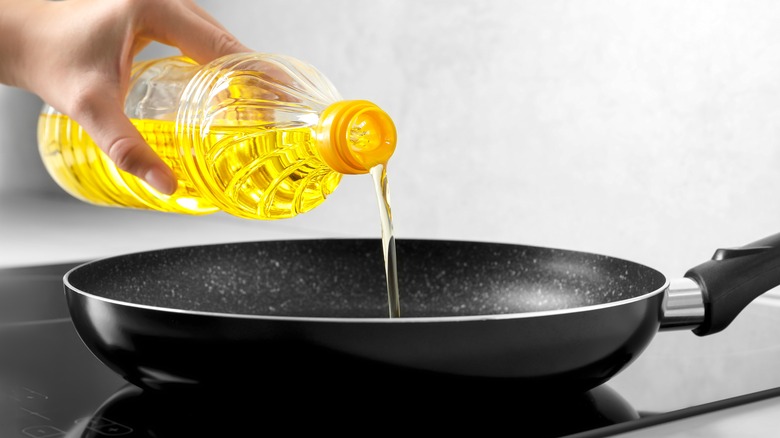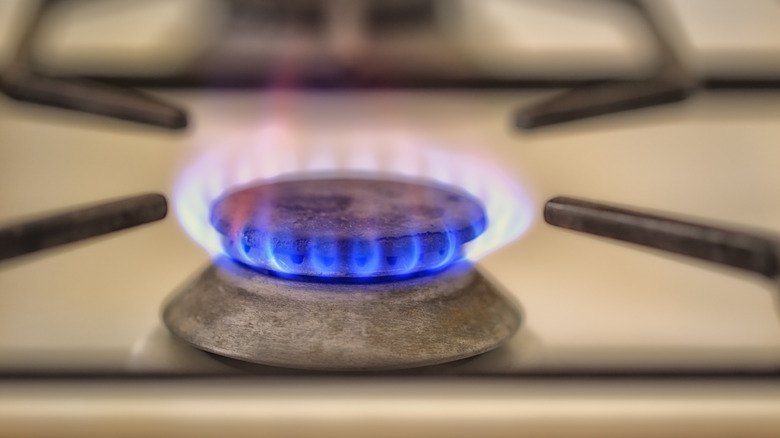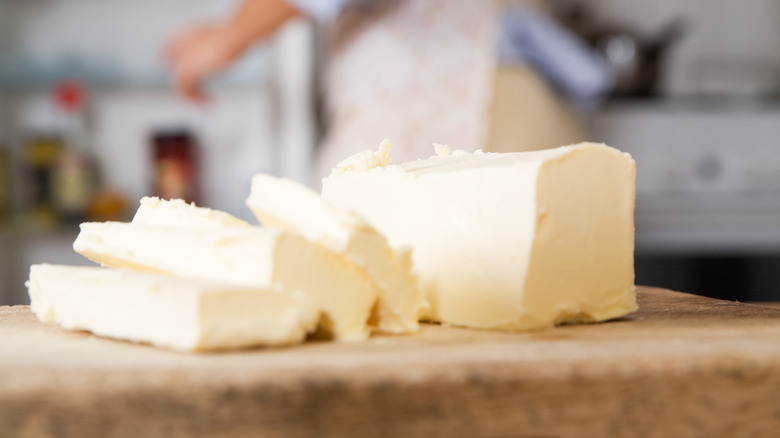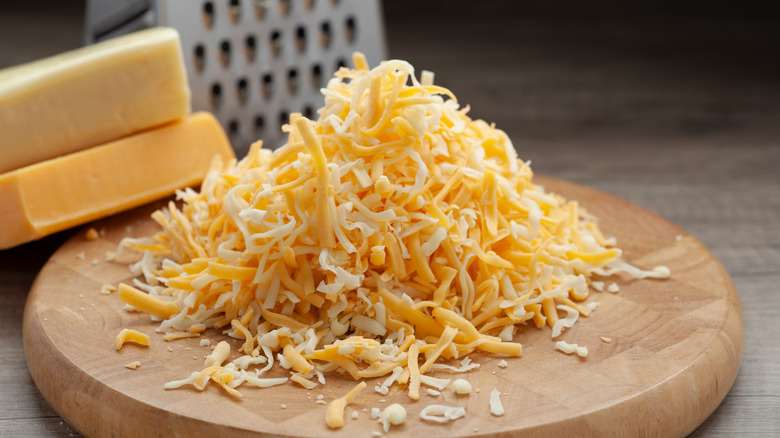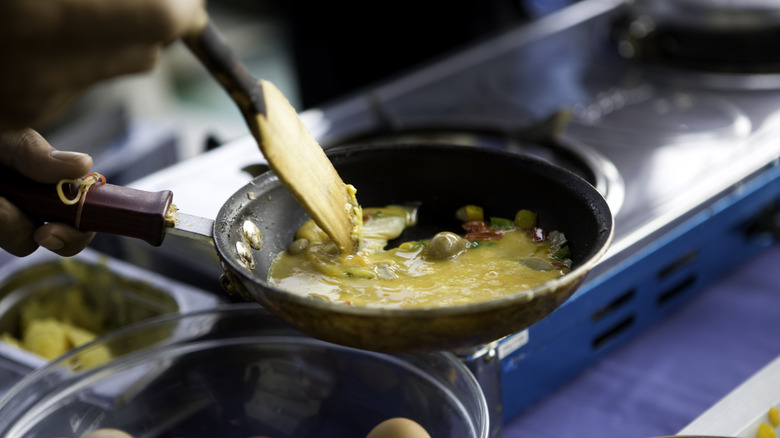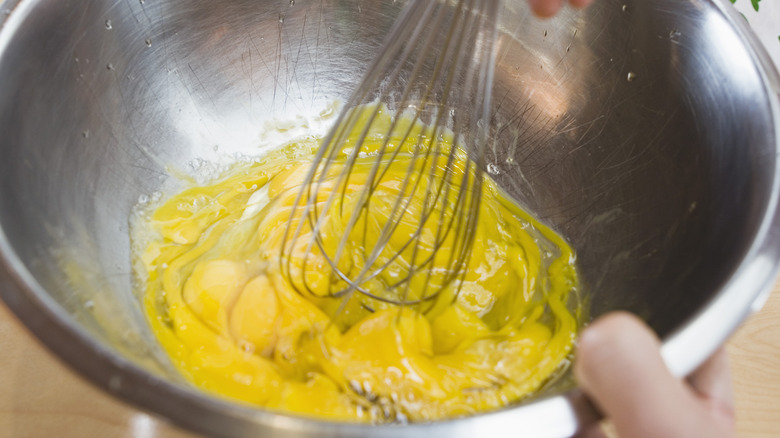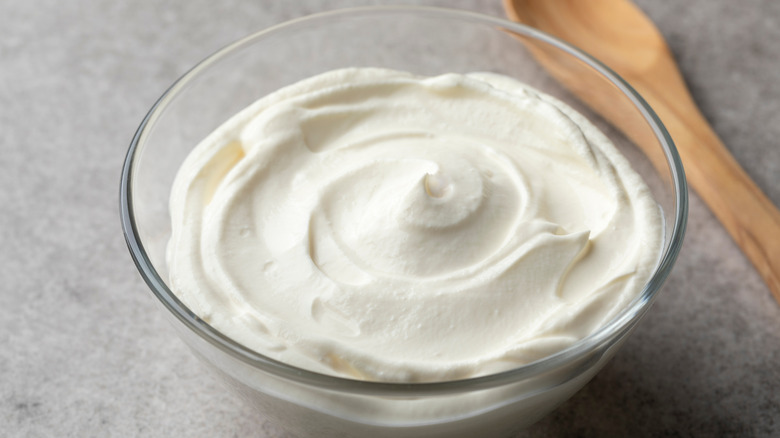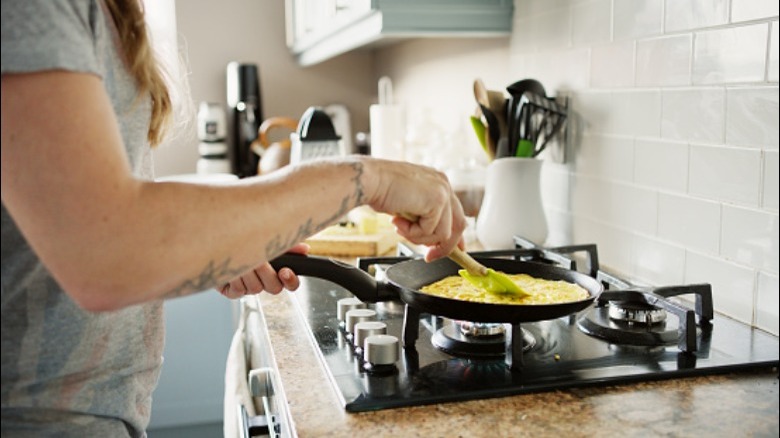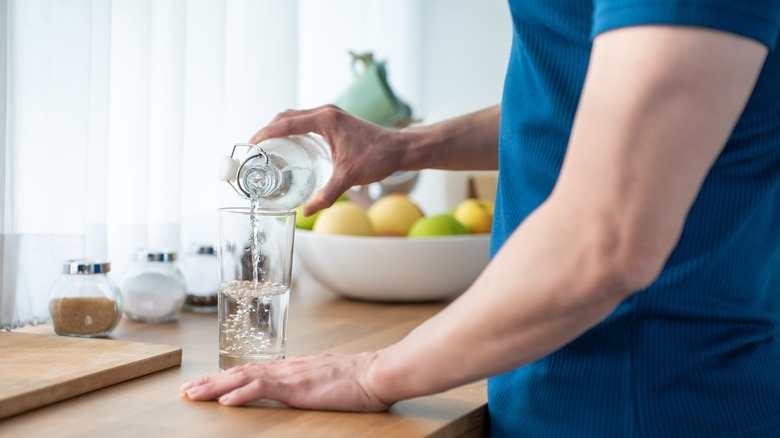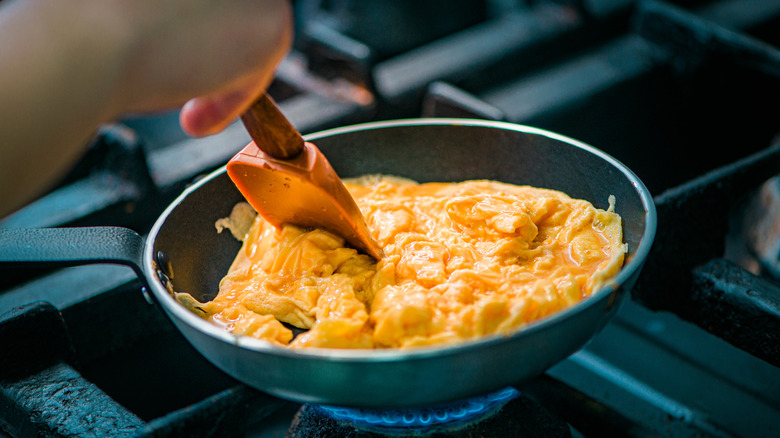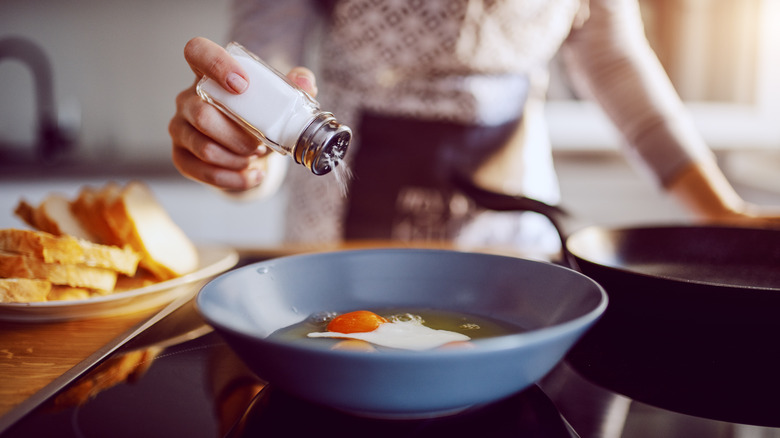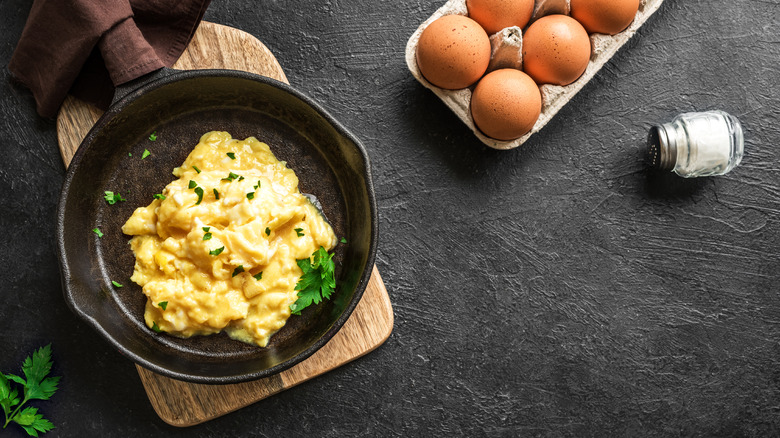The Biggest Mistakes Everyone Makes With Scrambled Eggs
Scrambled eggs are a breakfast staple that can be a perfect protein-rich side to waffles, pancakes, and French toast. But they also work just as well as the star of the show. They are notoriously easy to make, requiring few ingredients and just one pan. However, making scrambled eggs and making scrambled eggs well are two sometimes entirely different matters. While the process is not overly complicated, there are many mistakes one can make when it comes to scrambled eggs. If you have ever wondered why a relative or restaurant's scrambled eggs are so much better than the ones you've been cooking at home, you may be making one of these key mistakes.
It is not just the taste of the scrambled eggs that are affected by these common stumbles. An incorrect method can often lead to damaged pans or a more difficult cleanup. Surely no one wants to start the day with a hard-to-scrub pan. With our tips, you will have an easy and delicious breakfast to start your day off with the right food. As they say, breakfast is the most important meal of the day, and scrambled eggs are perfect for the job.
Using old eggs
Not all eggs are created equal. Anyone who has seen the deep orange yolk and the variation in shell color and size of a farm egg already knows that. However, many of us do not have access to eggs fresh from a chicken to cook with daily. Thankfully, that's okay. As the Barefoot Contessa herself has reminded us, "Store-bought is fine." If you do get your eggs from the store, make sure they are as fresh as possible.
As eggs age, a few things happen that make them less than ideal for most cooking purposes, including scrambled eggs. The texture of both the white and yolk change, becoming looser and more runny, which will negatively impact the texture of your scrambled eggs.
To test the age of the egg, fill a cup with water. A fresh egg will sink to the bottom and lay flat. A middling egg will stand on the bottom point up, and an old egg will float. This is because as eggs age, moisture inside the shell evaporates and is replaced by air. For scrambled eggs, you want eggs that lay flat on the bottom, as the freezer eggs will help you achieve perfectly tender results.
Old eggs that are not rotten yet still have their use. Somewhat aged egg whites are great for whipping, while hard-boiled eggs are said to peel more easily if you use old eggs. Just don't use them for your scrambled eggs.
Cracking the egg on the edge of a bowl
Most of us learned how to crack an egg at a fairly young age, surely breaking more than a few in the process. The sad truth is many of us learned incorrectly. While it may seem counterintuitive, cracking eggs on a flat surface is better than using the edge of a bowl. The first, and possibly most important consequence of the bowl technique is the higher risk of food contamination. When you crack a shell on the side of a bowl, raw egg is likely to run down the side, possibly introducing bacteria to the rest of your kitchen.
The other issue is little pieces of shell getting into your bowl. There is nothing worse than trying to fish out shards of broken shells. When you crack an egg on a flat surface, the membrane inside the shell typically remains intact. This means no egg on your counter, and you will be more likely to end up with a clean break instead of a bunch of little shell pieces flying into your scrambled egg mixture.
If you do find you have a piece of eggshell in the bowl, use the now-empty half of the eggshell for easy removal.
Not heating up the pan first
If you find that every time you make scrambled eggs, they stick to your pan and create a difficult cleanup, there is a good chance you are not heating your pan first. It does not matter whether you are using a non-stick pan, cast iron, or stainless steel. If you have not preheated your pan before adding fat and eggs, your eggs are more likely to stick to the surface, no matter the material.
The pre-heat does not have to be intense. Just bring the pan to the temperature you want it to be when cooking. For most materials, you'll know it's ready when a droplet of water will dance on the surface and evaporate quickly.
Of course, different pans take different times to properly preheat. Non-stick pans and stainless steel can preheat in just a few minutes, whereas cast iron can take upwards of 10 minutes to come to the ideal scrambled egg cooking temperature. When in doubt, test your pan with a few drops of water.
Cooking at too high a heat
Just as failing to properly preheat your can potentially ruin your eggs, cooking your scramble at too high a temperature can also quickly lead to subpar eggs. Have you ever wondered why eggs turn out dry and rubbery and fail to have the silky smooth consistency that you want from a good dish of scrambled eggs? Well, cooking them at too high a heat can be the reason.
Eggs are made up of two basic things: water and protein. As eggs cook, the protein inside begins to change shape and stick together. This turns the eggs from a raw liquid into a solid structure, but it can also be too much of a good thing. Overcooked eggs will dry out and take on a gummy texture.
Chef Ronnie Woo explains that when it comes to making scrambled eggs, low and slow is the name of the game, meaning you should set the pan on low heat to avoid overcooking the eggs. Yes, this takes longer, but it is key to making perfect scrambled eggs. Woo explains that it is the difference between a few minutes, not hours. Take the time, and you will be rewarded with the soft, pillowy eggs of your dreams.
Not using enough fat
Using some kind of oil or butter is crucial to successfully scrambled eggs. Not only does the addition of fat help prevent eggs from sticking to the pan, but it also keeps them from drying out completely while they cook. Many people might reach for some sort of non-stick spray, but a light coating from that may not be enough to reap all of the benefits of using fat with scrambled eggs.
Suggestions vary on how much oil or butter should go into the pan, from one teaspoon to two tablespoons per egg, depending on the pan type and size. Even if you are sticking to the low end of things, a serving size of the cooking spray typically equals just one-twentieth of a teaspoon of oil. This is 20 times less than the minimum recommendation. Most people are likely to spray for longer than the serving size recommends, however. This can be a good thing for your eggs, but it still may not be enough to get a really good scramble.
Now, we're not saying that you should never use spray oil, as the convenience of this ingredient is a big factor in many home kitchens. Simply be aware of how you apply that oil to the pan, especially when it comes to quantity. Additionally, consider what fat you use based on your flavor preference. Butter, olive oil, and vegetable oil are all acceptable, and each brings a unique flavor that will affect your scrambled eggs.
Using pre-shredded cheese
If you like cheesy scrambled eggs, we bet you often simply reach for a bag of pre-shredded cheese that is sitting in the fridge. While this is easy, using pre-shredded cheese comes at the cost of your scrambled egg texture.
Scrambled eggs are prone to several issues, including drying out. Meanwhile, shredded cheese is typically coated in anticaking agents. It makes sense, as cheese is naturally moist and sticky, and the manufacturer wants to ensure that the shreds stay manageable. The problem is these anticaking agents typically use some kind of starch or cellulose that pull moisture out of the cheese to keep the shreds from sticking. This interferes with the ability of the cheese to melt, meaning it can be difficult to incorporate it into your scrambled eggs.
Andrew Rea of Binging with Babish showed the difference between melting freshly grated cheese and pre-shredded cheese on TikTok. In his video, the pre-shredded cheese leaked fat and did not form a homogeneous whole. So, do the right thing and shred your own cheese for scrambled eggs.
Using the wrong size pan
We know that doing dishes is one of the worst chores of all. We are certainly all guilty of leaving dishes sitting in the sink for a time. However, doing a bit of washing up is worth it to make sure you have the right pan ready for your scrambled eggs.
Why does pan size matter so much? If you use a small pan, not only do you run the risk of sloshing partially-cooked eggs over the side, but the eggs are also more likely to stick to the pan, leading to more intense cleanup.
Don't overcompensate with a pan that is too large, however, as it can cause the eggs to spread out and quickly overcook. To do it right, use a 5-inch pan for one egg, an 8-inch one for two to three eggs, and a 10-inch pan for more than three eggs.
Overmixing your eggs
One of the biggest hints to making perfect scrambled eggs is right there in the name. This dish isn't puréed or blended, but scrambled. You might be urged to use a whisk, immersion blender, or any number of other kitchen implements to create a perfectly smooth scrambled egg base, but this extra step is entirely unnecessary and may even be against making perfect scrambled eggs. That's because many of these mixing methods add air to the beaten eggs, which can result in a dry dish.
The good news: the best way to mix your eggs requires just a fork. Beat the eggs with a fork using a side-to-side motion and remember that there is no need for a perfectly homogeneous mixture, as you will continue mixing your eggs in the pan.
Another option is to follow the steps of the viral TikTok Japanese omelet and use chopsticks. This will also perfectly beat the eggs, creating the ideal texture for scrambling without incorporating too much air. The result is a luscious scrambled egg experience.
Not adding a creamy element
Eggs on their own have fat in the yolk, but scrambled eggs benefit from an added creamy element to help them stay moist and supple as they cook instead of turning into a hard mess. Adding fat to eggs prevents the protein from bonding and results in a more desirable tender texture.
There are a couple of ways to add an extra creamy ingredient to your eggs. Instead of just buttering the pan, as add butter directly to the raw egg mixture before cooking. The butter does not need to be melted and can be simply cut into small pieces and added to the eggs. It will melt as it cooks, tenderizing the texture and keeping everything tasty.
Gordon Ramsay is known for using crème fraîche in his scrambled eggs. The mildly tangy flavor and high fat content of this ingredient make it an excellent addition to scrambled eggs. Others use heavy cream or half-and-half. If you are avoiding dairy, add additional egg yolks into the mix. You only need one egg yolk for every three to four eggs for a more custard-like scrambled egg.
Not moving the eggs enough
When it comes to scrambled eggs, keep your eyes on the pan at all times, as you'll want to keep them almost constantly moving. As chef Ronnie Woo explains, the goal is to keep the eggs out of direct contact with the pan for as long as you can. Even though they are ideally being cooked on low heat, allowing a portion of the scrambled eggs to sit in contact with hot metal for too long can cause the egg proteins to become unpleasantly rubbery.
Think back to that viral TikTok Japanese omelet. The chef keeps the eggs constantly moving until it's time to form a skin around them and turn the scrambled eggs into an omelet. Yet, the inside is still perfectly moist. Since the goal here is scrambled eggs and not an omelet, simply continue cooking to the desired doneness. Just remember to use your cooking utensils to keep the eggs moving and to preserve the scramble's moisture.
Not adding liquid
We have spent a lot of time focusing on how to prevent the egg's protein from hardening, but the liquid component of scrambled eggs is equally important. If you used something like crème fraîche in your eggs, then congrats, as you've already added both liquid and fat. But if you are looking for something more subtle to round out your scrambled egg mixture, consider bringing some extra liquid to the mixture.
Many people like to add water or milk to their scrambled eggs. In an experiment, Southern Living found that water yielded a fluffy and deeply egg-flavored dish, whereas milk mellowed the flavor and added a creamy note. The addition of liquid also helps to steam the eggs, which makes them extra fluffy.
While both milk and water are good options to achieve this goal, it should be noted Dolly Parton herself told Insider that she prefers to use ice water when cooking scrambled eggs. Who are we to argue with Dolly?
Using the wrong cooking utensil
When it comes to scrambled eggs, a metal spatula is not your friend. While it can be a handy tool in other situations, using a metal spatula to move scrambled eggs around will, at best, result in subpar scrambled eggs. At worst, it can ruin your pan.
A metal tool can scratch non-stick pans and may even leave little pieces of the coating in your food. This isn't as bad of a problem on stainless steel and cast iron pans, though those materials can get scratched, too.
Also, a metal spatula simply isn't suited to the task of scrambling eggs. Remember, you are not flipping the eggs, you are scrambling them. A wooden spoon or chopsticks work fine, though the ideal tool is a silicone spatula. This allows you to gently and easily move the eggs around the pan with a high degree of control. The fact that it doesn't have a hard surface shouldn't matter because, using the above tips, the scrambled eggs should not stick to the bottom of the pan. This tool also ideally has a flat surface to easily remove the scrambled eggs from the pan.
Seasoning too early
It can be tempting to mix your salt, pepper, and other seasonings with the raw eggs just before or while you scramble them. This may seem like a time-saver, but adding seasoning too early in the process can ruin your scrambled eggs.
For example, salt and raw eggs do not play together very nicely. Adding salt too early will inhibit protein formation and can result in goopy eggs. We are all for soft scrambled eggs, but not soggy ones. Instead, wait until the eggs have mostly cooked, then add your salt for the desired flavor bump.
Similarly, add fresh herbs after the eggs have already begun to cook. This helps to preserve the flavor and texture of these herbs. Also, remember that scrambled eggs do not take very long to cook, so make sure you have your seasonings ready to add to the eggs before you start cooking.
Letting cooked eggs sit in a hot pan
Congratulations, you have made perfectly cooked scrambled eggs! But don't allow them to sit in the hot pan a moment longer, or you might ruin those just-right eggs. Have you ever wondered why breakfast buffets have pans of scrambled eggs that make you feel like you're eating rubber? That's because chafing pans continue to cook the eggs to the point of being overdone. The difference between done and overcooked eggs can be a matter of seconds. Additionally, the longer the eggs sit in the pan, the more likely a skin will form, turning your scrambled eggs into something more like an omelet.
To avoid this, remove the eggs from the pan a little early. Try taking them out while they are still slightly undercooked (though definitely not raw, for safety reasons). Because they're still hot, the eggs will continue to firm up on your plate.
